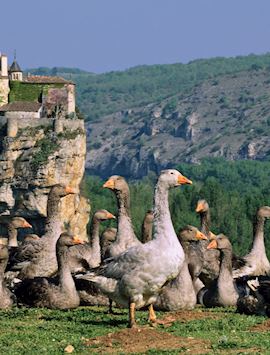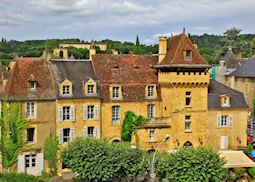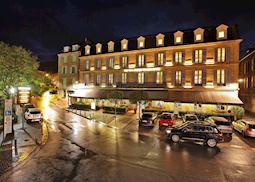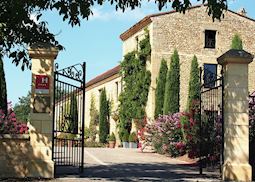Jump to:
One of the most intact historic towns in France, Sarlat-la-Canéda’s medieval streets are lined with honey-toned buildings dating from across the ages. Half-timbered townhouses, Baroque doorways, Renaissance mansions, stone towers and hidden chapels sit on almost every street in this official ‘Town of Art and History’. Most date from the 15th and 16th centuries when Sarlat, as it’s locally known, was an important political and judicial hub. It’s best to explore on foot, leaving plenty of time to wander down side streets and stop in the some of the many little restaurants, shops and cafés that spill out on the streets.
France specialist LeanneI think that this is the best place to stay when you’re exploring the Dordogne. Not only is it convenient for reaching all the sights, but the historic part of town is beautifully preserved and has some of the best restaurants in the area.
Things to see and do in Sarlat-la-Canéda
Saint-Sacerdos Cathedral and the Lantern of the Dead
The original church of Sarlat Abbey, the cathedral was first founded in the 1100s but was rebuilt in the 16th and 18th centuries. Its façade is largely Romanesque in style, while the central nave is Gothic. To the rear is the 14th-century church of Saint-Sauveur. Behind the cathedral lies the Jardin des Enfeus, the old abbey cemetery, where you’ll find a number of enfeus (tombs built into the walls) as well as the unusual Lantern of the Dead, a tapered tower that is thought to have been built to mark a visit by Saint Bernard, one of the founders of the Cistercian order, in 1147.
Place de la Liberté
Sarlat’s main square, Place de la Liberté, is surrounded by imposing buildings dating from medieval and Renaissance times, with turrets, towers, balconies and ornate rooftops creating a pleasing jumble of styles. The town hall with its circular bell tower is here, as are a large number of cafés and restaurants making it a pleasant place to linger over a drink or meal and just watch the world go by. For the last two weeks of July, the square is the venue for an outdoor festival and comes alive with performances of classical and contemporary drama.
Saint-Marie Church and covered market
One of the most imposing buildings on Place de la Liberté is the 14th-century Saint-Marie Church with its monumental metal doors. Eminent French architect Jean Nouvel was born in Sarlat and was commissioned to transform the disused church, which was damaged during the French Revolution, into a covered market. Inside, contemporary features sit seamlessly alongside the original Gothic architecture and the market stalls which sell traditional local produce. The highlight, however, is the glass lift inside the original bell tower. The lift extends beyond the top of the tower offering panoramic views of Sarlat and its surroundings.
Local markets
Sarlat is well known for its produits du terroir (local produce) and particularly renowned for its foie gras and truffles. The covered market is a good place to look for such delicacies and there are a whole host of small shops and delicatessens lining the narrow streets. More atmospheric, however, are the weekly markets which are held on Wednesdays and Saturdays on the cobbled streets in front of the cathedral and on Place de la Liberté. Look out for local cèpe mushrooms, walnuts, duck or goose confit (conserve), local cheese and honey. Between December and February you’ll also find a Saturday morning truffle market on Place Boissarie.
Le Manoir de Gisson and Place du Marché aux Oies
On Rue des Consuls you’ll find the 13th-century Manoir de Gisson tucked in between a series of mansions. Its two buildings are joined by a hexagonal tower and inside, you can see the rooms which would once have been the private apartments of the Sarlat nobility with their huge fireplaces, wood panels and period furnishings. You can also visit the vaulted cellars which contain an exhibition on the history of justice in the region. Outside, on the Place du Marché aux Oies (Goose Market Square), three life-size bronze geese mark the location of the town’s goose market which takes place in March.
Best time to visit Sarlat-la-Canéda
April to June and September to October are the best times to visit because Sarlat-la-Canéda can get crowded in the height of summer. In late January the town hosts a truffle festival, while in early March, the town’s goose festival sees the streets filled with live birds and market stalls before a grand outdoor feast.
who's been there

Start planning your tailor-made trip to ³§²¹°ù±ô²¹³Ù-±ô²¹-°ä²¹²Ôé»å²¹ by contacting one of our France specialists
-
617-223-4521617-223-4762
- Make an inquiry
Suggested itinerary featuring ³§²¹°ù±ô²¹³Ù-±ô²¹-°ä²¹²Ôé»å²¹
This sample itinerary will give you an idea of what is possible when you travel in ³§²¹°ù±ô²¹³Ù-±ô²¹-°ä²¹²Ôé»å²¹, and showcases routes we know work particularly well. Treat this as inspiration, because your trip will be created uniquely by one of our specialists.
Places near ³§²¹°ù±ô²¹³Ù-±ô²¹-°ä²¹²Ôé»å²¹
- La Roque-Gageac 5 miles away
- Beynac-et-Cazenac 5 miles away
- Castelnaud-la-Chapelle 7 miles away
- Dordogne 39 miles away
- ³§²¹¾±²Ô³Ù-ɳ¾¾±±ô¾±´Ç²Ô 67 miles away
- Bordeaux 89 miles away
- Chinon 165 miles away
- Château d'Azay-le-Rideau 168 miles away
- Château de Chenonceau 169 miles away
- Biarritz 169 miles away
- ±«³úè²õ 170 miles away
- Château de Villandry 173 miles away
- Amboise 176 miles away
- Pont-du-Gard 177 miles away
- Château de Chaumont-sur-Loire 180 miles away
- Château de Cheverny 181 miles away
- The Loire Valley 185 miles away
- Orange 185 miles away
- Lyon 186 miles away
- Châteauneuf-du-Pape wine region 188 miles away
- Avignon 189 miles away
- Arles 189 miles away
- Château de Chambord 190 miles away
- Les-Baux-de-Provence 194 miles away
- ³§²¹¾±²Ô³Ù-¸éé³¾²â-»å±ð-±Ê°ù´Ç±¹±ð²Ô³¦±ð 195 miles away
- L'Isle-sur-la-Sorgue 202 miles away
- ¸é³óô²Ô±ð-´¡±ô±è±ð²õ 208 miles away
- Gordes 209 miles away
- ²Ñé²Ô±ð°ù²ú±ð²õ 211 miles away
- Roussillon 213 miles away
- Aix-en-Provence 230 miles away
- Annecy 249 miles away
- Talloires 252 miles away
- Provence 254 miles away
- Paris 280 miles away
- Normandy 281 miles away
- Chamonix 283 miles away
- Mont Saint-Michel 290 miles away
- Saint-Tropez 292 miles away
- The French Riviera 293 miles away
- Grasse 296 miles away
Photos of ³§²¹°ù±ô²¹³Ù-±ô²¹-°ä²¹²Ôé»å²¹
Accommodation choices for ³§²¹°ù±ô²¹³Ù-±ô²¹-°ä²¹²Ôé»å²¹
We've selected a range of accommodation options for when you visit ³§²¹°ù±ô²¹³Ù-±ô²¹-°ä²¹²Ôé»å²¹. Our choices usually come recommended for their character, facilities and service or location. Our specialists always aim to suggest properties that match your preferences.
-
![Hôtel-Restaurant la Couleuvrine, ³§²¹°ù±ô²¹³Ù-±ô²¹-°ä²¹²Ôé»å²¹]()
Hôtel La Couleuvrine
³§²¹°ù±ô²¹³Ù-±ô²¹-°ä²¹²Ôé»å²¹ -
![Plaza Madeleine, ³§²¹°ù±ô²¹³Ù-±ô²¹-°ä²¹²Ôé»å²¹]()
Plaza Madeleine
³§²¹°ù±ô²¹³Ù-±ô²¹-°ä²¹²Ôé»å²¹ -
![La Villa Romaine]()
La Villa Romaine
³§²¹°ù±ô²¹³Ù-±ô²¹-°ä²¹²Ôé»å²¹




